Thoughts from My Visit to AiG’s Ark Encounter & Creation Museum
Image
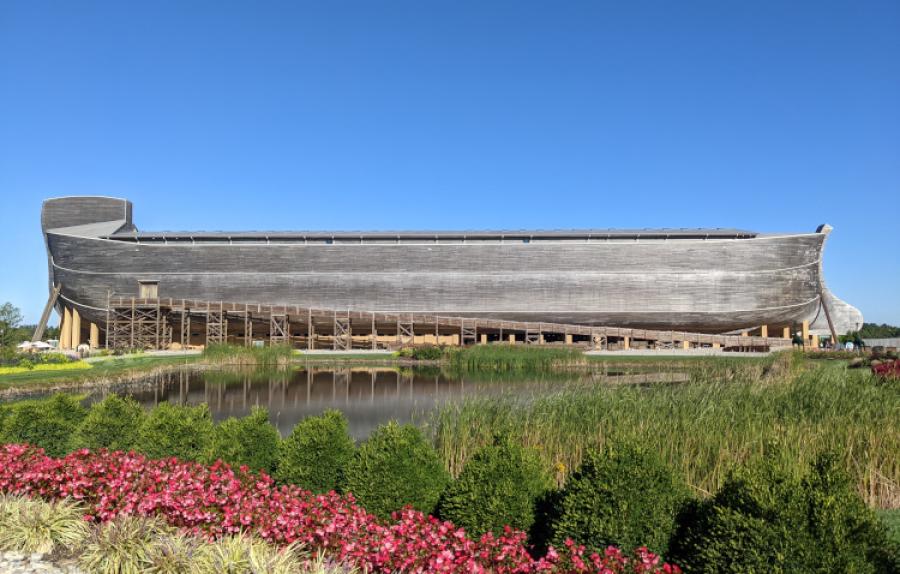
Those who have visited Answers in Genesis’ Ark Encounter or Creation Museum will have their own perspective on the experience and its value. I’ve just returned from my own first-time visit to both and have some observations and thoughts for those who haven’t yet made the pilgrimage.
Is it just a big entertainment business making a few people rich?
Revenue is an inherently tempting thing. Just getting a paycheck every couple of weeks brings hazards as well as blessings. One of the hazards is that as revenue increases, my life and work might become increasingly about revenue.
We’d be fools to think that Ken Ham and Answers in Genesis are invulnerable to that temptation. There are also signs that could be viewed as evidence that AiG is on that road.
- It’s Number 1: The Ark Encounter and Creation Museum have made Northern Kentucky the biggest faith-based tourist destination in America.
- Answers In Genesis to Launch Answers.tv Streaming Platform
- The Latest Biblical Attraction: The Tower of Babel: Answers in Genesis plans a three-year expansion at its Ark Encounter site in Kentucky.
The growth above is in addition to AiG’s already-expansive ventures into Sunday School, VBS, and homeschool curriculum.
Because of how evangelical ministry tends to drift, I had concerns about this before I went to Ark Encounter (Ark) and the Creation Museum (CM). Being there didn’t erase those concerns. I hope and pray that AiG won’t be sucked into the “more and more, and bigger and bigger, is better” trap that afflicts so many megachurches and other large ministries.
That said, I don’t believe that right now, AiG is just an evangelical entertainment biz, pandering to the lowest common denominator of evangelical thrill seekers and belief-validation seekers.
Some reasons why:
- If you’re going to do infotainment at all, you should do it right.
- Doing it right is expensive.
- AiG is shooting for top notch quality, and usually achieving it.
Pretty much everything at Ark is top-notch and nearly everything at CM is also (Exception: The planetarium show on aliens is much in need of an update. The show on the scale of the universe more than makes up for it, though!).
Both sites—which are a good 40 minutes apart by freeway—are kept in excellent condition and surrounded by extremely beautiful gardens. Both are full of exhibits that are as good as any I’ve seen anywhere. I’m not a museum buff, but Ark & CM rival the best museums I’ve toured in visual appeal, clarity, variety and thoughtfulness of the exhibits.
I imagine it would be hard for passionate non-believers to get past that and appreciate the quality of the exhibits, but it’s probably not hard for Christians with different views on the events of Genesis to appreciate.
Are these sites effective apologetics or just preaching to the choir?
Multiple aspects of both Ark and CM surprised me—a few examples:
- Though it has “theme park” like stuff on site (zip line, camel rides for kids, a VR show of some sort, etc.), the Ark itself is pretty much a museum housed inside an exhibit … a cool idea by any standard.
- The love of Christ and the gospel pops up all over in all sorts of ways, both subtle and intentionally non-subtle. In places, the gospel is portrayed with extraordinary beauty and grace. I teared up a bit more than once.
- The level of detail! Multiple times during our day there, my critical thinking circuits would go, “Hmmm, but what about this…?” only to later find that very question directly addressed. The evidence and reasoning in the answers is selective—it has to be—but AiG seems to have thought of all the questions.
- With a few givens in place (e.g., “kinds,” no hibernation, cubit size), I found the project persuasive as a demonstration of one way Noah’s ark could have done the job literally as described in Genesis.
- Tone: The tone is mostly educational, not polemical. I also saw less inappropriate dogmatism than I expected.
But are these sites effective apologetics? Several points on that.
- Ark is definitely more infotainment-oriented than CM.
- Both are clearly aimed at general audiences, not intellectual elites, though CM is a bit more toward that end of the scale.
- Both are clearly aimed at declaring the whole gospel story and educating Christians about Genesis—not mainly equipping believers for debates with skeptics or winning over critics on intellectual grounds.
- Ark is not presented as a “you can believe Genesis now that you’ve seen it” thing. It’s more of a “you can understand Genesis better now that you’ve seen it” thing.
If you go to learn, you won’t be disappointed. If you go hoping to use something there to win your agnostic or atheist friend to Christ—there’s good stuff for that also, but probably not in the “conversion by winning the debate” vein.
Could it be better in some ways?
You can always find ways to make something better.
Infotainment. The blending of “theme-parkiness” with “museuminess” involves some trade-offs. If you dial down the entertainment aspect, you reach fewer people, including some who would be drawn into more thoughtful engagement with the ideas. But the entertainment aspect feeds the skepticism of those who are approaching the big questions more intellectually and suspect the projects are just fun and games and money. I’d like to see CM become even less theme-parky, though it’s already noticeably less so than Ark.
Counterarguments. At multiple points in both Ark and CM, but especially CM, I was aware that there are alternate views and counterarguments against what AiG was presenting. I couldn’t recall what they were and thought the exhibits might be enhanced by acknowledging these more and maybe pointing inquirers to where they can dig deeper into those debates. For example, CM is emphatic that earth must be 6,000 years old because the genealogy in Genesis notes the ages of individuals when they died—so there can’t be gaps. The exhibit leaves it at that.
You can only say so much in exhibit format—and many of CM’s exhibits are already a lot of reading. So I sympathize. Still, maybe there’s a way to use tech to allow guests to tap a Dig Deeper icon and find out why, for example, some still see maybe tens of thousands of years in Genesis but still consider themselves young earth creationists.
Assumptions. Ark is extremely well imagined, and I use “imagined” intentionally. It’s full of detailed explanations of how waste disposal, food distribution, ventilation, water, and more may have been engineered to allow eight people to care for around 800 animals each. Some brilliant engineers had to work through all of that—which means Noah, his family, and whatever other resources he could access, would also have to have done a lot of brilliant engineering.
I don’t find that difficult to believe. There was plenty of time to design and test systems, find failure points, and design new ones, etc. Also, though “Noah built the ark,” we don’t have to believe he never hired anybody for design, materials, and labor.
But a huge portion of the project is built on the assumption that God didn’t simply put all the animals into hibernation. I’m aware of the counterargument that Genesis doesn’t mention hibernation, so we’re filling in gaps from our own thinking on that. But if you visit the Ark you can hardly help but realize Genesis also doesn’t mention intricate waste disposal, food distribution and water management systems! Any view that takes the flood and ark account as historical/factual has two choices:
- Leave the details to God: “It’s not important to me how God made it all work.”
- Imagine a great deal to theorize how it all could have been done.
A portion of a small animals exhibit from Ark…

A portion of a large animals exhibit at Ark …
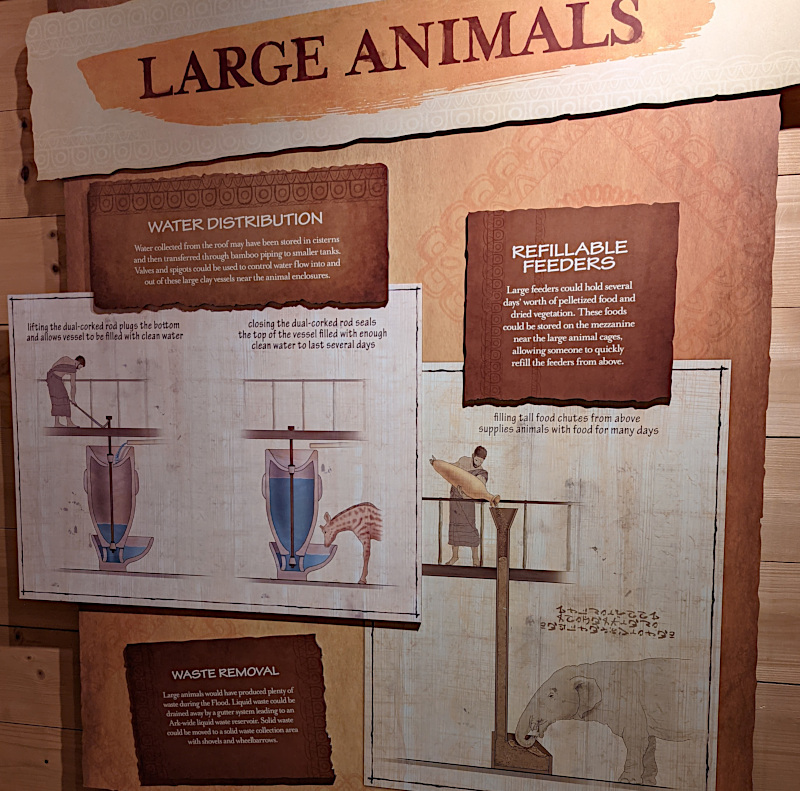 Is it less biblical and theologically sound, or more presumptuous, to imagine hibernating animals, a smaller cubit, and a smaller ark that isn’t so thoroughly engineered? (AiG’s attitude is that maybe hibernation happened but it wasn’t necessary.)
Is it less biblical and theologically sound, or more presumptuous, to imagine hibernating animals, a smaller cubit, and a smaller ark that isn’t so thoroughly engineered? (AiG’s attitude is that maybe hibernation happened but it wasn’t necessary.)
One other fact that hit me during these visits is that the AiG concept of “kinds” (Gen. 6:20, 7:14) means they do believe in the evolution of species. They would strongly prefer not to say it that way, because they define “evolution” as the complete naturalistic, molecules-to-man package. But in AiG’s view, a “kind” is a broader category than a species, and we have far more species today than Noah had “kinds” in his day. That would mean that after the flood, specimens of each kind evolved into the many species we have today—by natural selection (see photo of CM exhibit).
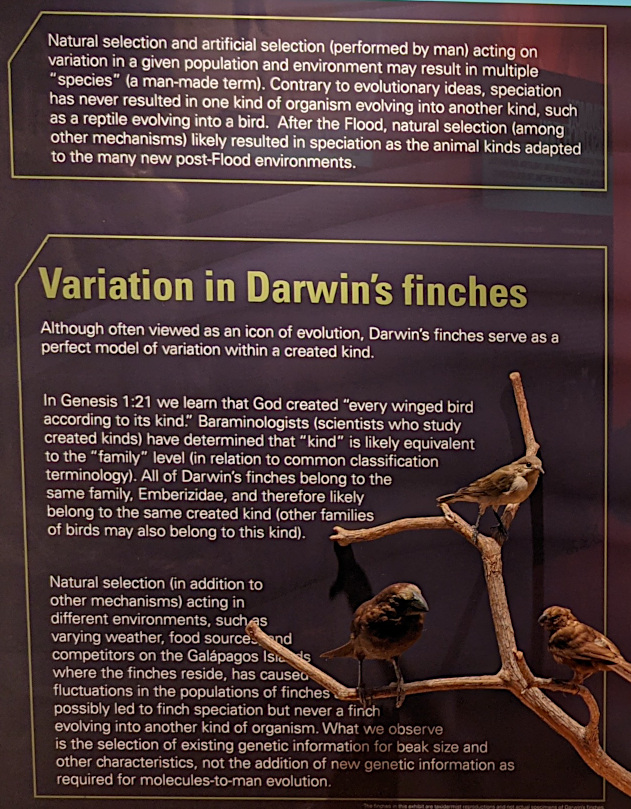
Given the relationship of kinds to species and the role of natural selection, maybe we need to stop being so broadly negative about “biological evolution,” and learn more nuanced ways of communicating the differences and similarities between creationist and naturalist views of life on earth.
Should you go?
You don’t have to be convinced that AiG has all the details right to benefit from the Ark Encounter and the Creation Museum. At the very least, these projects are thought-provoking, interesting, and well integrated with the theology of God’s grand plan of creation, fall, redemption, and restoration (CM uses the “Seven C’s” of Creation, Corruption, Catastrophe, Confusion, Christ, Cross, Consummation).
Believers don’t need to see a full scale ark model to be firm in their faith in God and His Word. Ark and CM are not about that. They’re about learning and deepening understanding as well as viewing the world in a more God- and gospel-centered way.
I think you should go. Should you bring your agnostic or atheist friend? That depends on a lot of factors, but it could certainly be a route to some thoughtful conversations about the big questions of what life is, why we’re here, what’s gone wrong, and what it all means.
A small animal storage area from Ark …
The graphic novel style gospel exhibit at Ark …
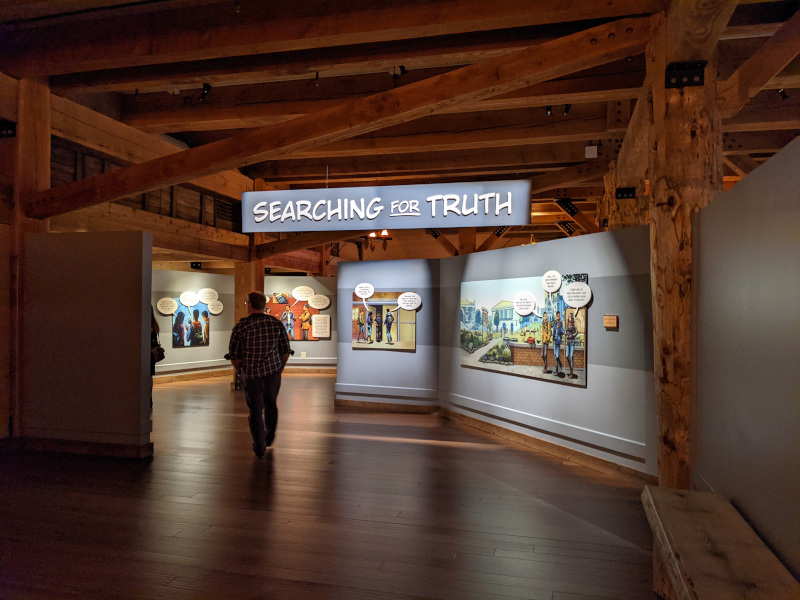
(Photo credits: Me and my Pixel 5.)
Aaron Blumer 2016 Bio
Aaron Blumer is a Michigan native and graduate of Bob Jones University and Central Baptist Theological Seminary (Plymouth, MN). He and his family live in small-town western Wisconsin, not far from where he pastored for thirteen years. In his full time job, he is content manager for a law-enforcement digital library service. (Views expressed are the author's own and not his employer's, church's, etc.)
- 231 views
Nice review and balanced - thanks
Questions for Aaron:
- Over the next decade, how many more times would you expect to go?
- How much out of pocket did you spend? (Not travel to & return costs). How many persons? (looking for cost per capita)
Asking b/c I question the long term financial viability of the project.
Thanks
What Dave White says, and I remember earlier discussion of this pointing out that AIG was more or less counting on similar visitation to that of Chicago’s Field Museum. Financial viability is rough in this regard.
Aspiring to be a stick in the mud.
I have also been to the Creation Museum, though it was in 2010, and there was no ark at the time. My wife and I were two of the chaperones of our church’s youth group.
In short, like Aaron, I was impressed with how the gospel was clearly presented, and the fact they had really thought out the answers to a lot of the questions people would ask, even if they couldn’t think of everything. It’s a great and fairly detailed presentation of the creation story, though I don’t know how convincing it would be to someone who is not already dissatisfied with what they have been taught by our secular school system all their lives, and seeking a better explanation.
I agree with Aaron’s thoughts on the planetarium show presenting the size and scale of the universe. That was very well done. I even bought a copy of that on Blu-ray later. There was no show on aliens at the time, and I don’t know if I’d have been interested enough to go see that, as no matter how well it would be done, it would be purely speculation, and I think would go a little against the seriousness of the ideas presented in the creation museum. I’m sure others would see it differently.
Back in 2010, there wasn’t much on the “entertainment” aspect as Aaron describes it. There were a few smaller shows/presentations where, for example, a museum guide would talk about reptiles, showing a bunch of them, and then you could hold a very large boa constrictor (with supervision) and things like that. I’m guessing much more entertainment-type stuff (e.g. the zip line) has been added since that time.
All-in-all, I was very impressed with the quality of the museum. It was definitely on the level of some of the better secular science museums I’ve visited. It is information-heavy, and maybe the extra “infotainment” has been added to appeal a little more to today’s generation that has been saturated with smart phones and similar, and thus has no attention span to speak of.
As to going again? Maybe if were taking others who hadn’t been. I’m already a convinced young-earth (though maybe not exactly 6000 years) creationist and Christian, and I don’t know that enough would change in the CM to make me want to revisit just for myself, especially at the price they are charging (which I didn’t think unfair, but it was certainly not cheap). I’ve not been to see the ark. At first, I thought it would be too much of a gimmick, though after reading Aaron’s review, I might go with another group at some point.
One of the things that makes me go to my local science museum more than just once is a special area they have for one-time/traveling exhibits. They also have some events yearly that are fun for kids and adults alike. I think any museum needs to have some of these “changing” exhibits to have a chance to get a decent amount of repeat business.
Dave Barnhart
My wife and I have been to the Ark Encounter. We got our tickets for free. I would not spend $50 / person to go again.
I’ve never been to the Creation Museum. I might spend $40 / person to go once.
Like Aaron, I was impressed with the approach and quality of the Ark Encounter. I wasn’t impressed with the petting zoo or the other attractions on site.
I would recommend people visit the Ark Encounter at least once, but look for discounted tickets. If your church uses AiG materials (Sunday school or VBS), you may be able to get discounted or free tickets.
Aaron said “The show on the scale of the universe more than makes up for it, though!”
Speaking as a physicist, astronomer, and cosmologist, how can anyone rationally claim to measure the size of the universe beyond 6,000 ly if you insist the universe is only 6,000 years old? You can’t use the speed of light, and hence any official measurement to do it. I’ve often thought the most ridiculous thing “young earthers” do is claim the universe is huge. How do they know? The way astronomer’s measure the universe’s size relies on something the “young earthers” deny whole-heartedly. So why use it? They use it because everyone knows the universe is huge….
The only way you could possibly do it is with relativistic effects, and EVERY young earther I’ve met poo-poo’s such things.
[Mark_Smith]Aaron said “The show on the scale of the universe more than makes up for it, though!”
Speaking as a physicist, astronomer, and cosmologist, how can anyone rationally claim to measure the size of the universe beyond 6,000 ly if you insist the universe is only 6,000 years old? You can’t use the speed of light, and hence any official measurement to do it. I’ve often thought the most ridiculous thing “young earthers” do is claim the universe is huge. How do they know? The way astronomer’s measure the universe’s size relies on something the “young earthers” deny whole-heartedly. So why use it? They use it because everyone knows the universe is huge….
The only way you could possibly do it is with relativistic effects, and EVERY young earther I’ve met poo-poo’s such things.
See John Sailhamer’s view:
https://www.desiringgod.org/articles/science-the-bible-and-the-promised…
Sailhamer argues that Genesis 1 and 2 recount “two great acts of God” (14). The first great act is the creation of the entire universe-our planet, the animals, the sun, moon, stars, etc. This is recounted in 1:1, which declares that “In the beginning God created the heavens and the earth.” The Hebrew word translated “beginning” does not mean an instant of time, but an”indefinite period of time.” Since, then, God created the entire universe in an unspecified period of time, “we cannot sayfor certain when God created the world or how long he took to create it” (14). For this reason, the scientific evidence for an old universe does not contradict Genesis one. And this is the case even if we interpret the “days” as twenty four hour periods and not ages of time.
I’ve seen you dismiss and disagree with young earth creationism quite a bit. Out of curiosity, what is your own view of how and when the universe came into being? How about humans?
[Dave White]Nice review and balanced - thanks
Questions for Aaron:
- Over the next decade, how many more times would you expect to go?
- How much out of pocket did you spend? (Not travel to & return costs). How many persons? (looking for cost per capita)
Asking b/c I question the long term financial viability of the project.
Thanks
I paid about 80 bucks for the combined ticket for both properties. The group was myself my sister and her husband and my mom.
I really don’t know how often I would be getting back down there. I do think it would be fun to go back alone sometime, so I can go through things slower in some places and faster in other places and focus on the things that most interest me personally.
If you have any interest at all in the topics you can easily spend a full day at each location.
I don’t recommend going with small children. I saw a lot of parents really struggling to keep their kids adequately stimulated / rested, etc. There are things there geared toward kids, but personally I would not want to do that. I’d get a babysitter.
Oh, another detail: eating just noon meals on site at both locations I probably spent about 30 bucks over the 2 days. I bought a hat for about 20 bucks in a gift shop because I forgot to bring my hat in the first day, and we were outdoors more than I expected…. History of melanoma and all that.
We stayed at an Airbnb about 35 minutes from Creation Museum and about an hour from Ark. It made for some unpleasant traveling through Cincinnati, but saved a ton of money on lodging. Due to the journey down and back we were there three nights.
Edit: One more thing that probably matters to those interested in financial viability of the project. Both Ark and Creation Museum were quite busy the two days we were there. I would say Ark was almost too crowded, though right at the limit of what I found reasonably comfortable. Creation museum was a bit less crowded though in places it was difficult to spend the time I wanted to, just due to feeling the need to keep moving because of so many people trying to get through it. So, if supply and demand mean anything, prices may actually need to be a little bit higher to shrink crowds a little. On the other hand, this summer might be more of a post-covid resurgence situation and not typical.
Views expressed are always my own and not my employer's, my church's, my family's, my neighbors', or my pets'. The house plants have authorized me to speak for them, however, and they always agree with me.
A couple thoughts on age of the universe.
First, as a unit of distance, the light year works regardless of how old you think the universe is. This is because today we know what the speed of light is and how long it takes a photon to get from point a to point b. I get what you’re saying about relativity and so forth, and I’ve read views about how time and the speed of light constant could have varied at various points near the very beginning of the universe. At the moment I’m not very interested in all that other than to say that the light year works as a unit of distance just fine regardless.
Secondly, if you go over to answersingenesis.org and just use their search tool you can find a variety of views on those topics and many more, though they’ve always got a preferred view they’re strongly advocating. I certainly don’t agree with them on every detail, and even where I agree with them I’m often less confident than they seem to be. But there’s a lot of interesting reading there, and it’s often more thoughtful and thorough than I expected to find.
Views expressed are always my own and not my employer's, my church's, my family's, my neighbors', or my pets'. The house plants have authorized me to speak for them, however, and they always agree with me.
Yes Aaron, but you can’t measure distances unless you assume a lot of things. Geometry alone gets you only to about 600-1000 ly with parallax. If you go greater than that, the models used by astronomers to measure distances ASSUME an ancient universe. For example, if you use Main Sequence Fitting, you assume stars live enormous lifetimes and produce energy by nuclear fusion over millions and billions of years. Those stars living these enormous lifetimes are well behaved and predictable, and live on the Main Sequence of the H-R Diagram. The predictableness of the Main Sequence stars enables astronomers to predict the absolute luminosity and hence measure the distance. No predictable long life… not absolute luminosity prediction and no measurement.
If you use Cepheid Variables, you assume Cepheid variables are old stars who have lost stability in a predictable way as the Helium ions in their atmospheres swap charges as the star swells and shrinks while heating up and cooling down. If you go farther than that you are relying on galaxy rotations (we’re talking millions and hundreds of millions of light years here). Even farther you are talking supernovas, the deaths of stars that have lived millions of years (if not why are they dying?).
[josh p]I’ve seen you dismiss and disagree with young earth creationism quite a bit. Out of curiosity, what is your own view of how and when the universe came into being? How about humans?
Its not that I disagree with YEC, its that you can’t have cake and eat it too. If you believe in a 6000 year old universe and earth, then everything astronomical you see around is PURE MIRACLE and science as defined by people (natural processes studied and applied to what’s out there) simply cannot be used to understand the universe. The light from the Sun, every single photon, if the energy of the Sun comes from nuclear fusion, is produced by processes way older than 6000 years!!! I cannot emphasize that enough. So if you accept the Sun gets its energy from fusion, that is tantamount to an old universe. If you say the universe is 6000 years old, then the energy of the Sun is all miracle produced, and not by fusion. So it is foolish to talk about nuclear fusion and a young universe. The same goes with distances. It is pure foolishness to talk about accepting measuring the Andromeda Galaxy to be 2.5 million ly away when that measurement relies upon light traveling 2.5 million ly to get here! It also relies upon a star that is millions or billions of years old to produce the Cepheid Variableness…
So, if the proper interpretation of Genesis 1 and 2 is that the universe is 6000 years old, there is no acceptable way to do astronomy of stars. So YEC adherents need to step up and realize what they believe.
as I am not hi-jacking this thread anymore.
Think about what I wrote. Study it out.
[Dave White]See John Sailhamer’s view:
https://www.desiringgod.org/articles/science-the-bible-and-the-promised-…
Sailhamer argues that Genesis 1 and 2 recount “two great acts of God” (14). The first great act is the creation of the entire universe-our planet, the animals, the sun, moon, stars, etc. This is recounted in 1:1, which declares that “In the beginning God created the heavens and the earth.” The Hebrew word translated “beginning” does not mean an instant of time, but an”indefinite period of time.” Since, then, God created the entire universe in an unspecified period of time, “we cannot sayfor certain when God created the world or how long he took to create it” (14). For this reason, the scientific evidence for an old universe does not contradict Genesis one. And this is the case even if we interpret the “days” as twenty four hour periods and not ages of time.
This is grammar not science here. It is worse than what Sailhamer says. If you have learned a little Hebrew go and look at that first word, bereshyt. Well, b is the word “in”. reshyt is “beginning.” The Hebrew word for “the”, the definite article, is h. Both b and h are prefixes. Here’s the thing, when you want to say “in the” you write b only but change the vowel under the b to lengthen it. Go look at bereshyt. It has the non-h vowel for b. In other words, it is “in beginning” not “in the beginning”. Most commentaries don’t even touch this, but find one and research it out.
Now I’m done.
It was this question which motivated my study of (and eventually a Ph.D. thesis in) cosmology.
Here’s my current thinking on the matter: first, I think the distances are quite solid. I would be astounded if they turn out to be off by even an order of magnitude, much less the six orders of magnitude necessary to turn 10,000 years into 10 billion. For instance, the Cepheid period-luminosity relationship is empirical, even if the currently accepted reason for it (based on standard stellar theory) turns out to be wrong. The surface-brightness fluctuation method and the H2O-maser methods are essentially geometric also. Furthermore, different methods give broadly similar results.
Second, I think there is abundant evidence for billions of years worth of processes having taken place in the universe. The propagation of light from distant sources is only one of those processes. Notice I said billions of years of processes, not billions of years of time.
Third, we have at least one explicit instance of an accelerated process during creation week: “And out of the ground the Lord God made to spring up every tree that is pleasant to the sight and good for food” (Genesis 2:9). Notice these trees sprang up out of the ground—they didn’t appear fully formed. So decades of growth process took place in less than a day.
Thus, it seems that God, as part of the act of creation, performed billions of years of work (including light propagation) in a few days—running time on fast-forward if you will. This is not the same as the typical “appearance of age” argument—the processes actually took place, just at a much faster rate, as if time itself were sped up. I don’t know if AiG has a favored theory or not, but Danny Faulkner (at AiG) has proposed something at least conceptually similar to this “quick-time” scheme.
Since the very concept of “creation” requires what we would call “miracles”, why is it unacceptable to believe God created all these processes in full operation, as if they had been operating for many years? Adam was not created as a newborn. He was created a fully functioning grown man from the first minute of his existence. If a scientist had examined Adam the day after his creation, using the information we have today, he would have pronounced Adam to be, say thirty years old. He would probably have insisted that it is preposterous to believe that Adam was only one day old. That claim defies everything we know scientifically about the human body. But Adam was actually only one day old. God did something unique with the creation of Adam that is completely different than what is true of every man who came after Adam. I think the Adam analysis is obvious. Why, then, do we quibble with the concept that everything else about creation follows a similar pattern?
G. N. Barkman
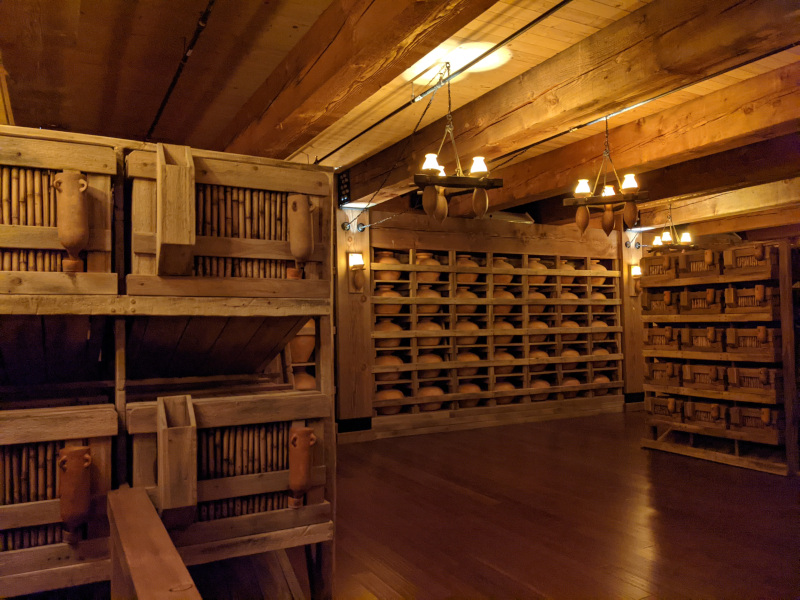









Discussion